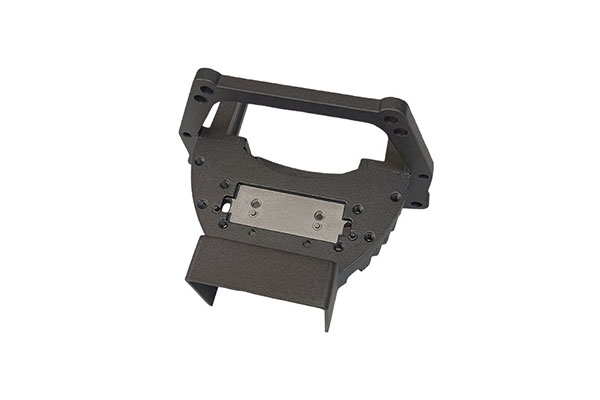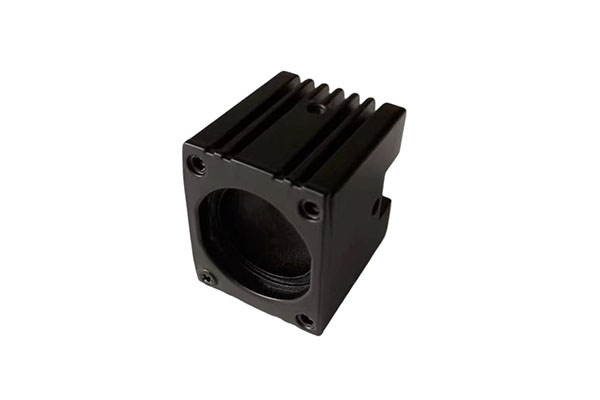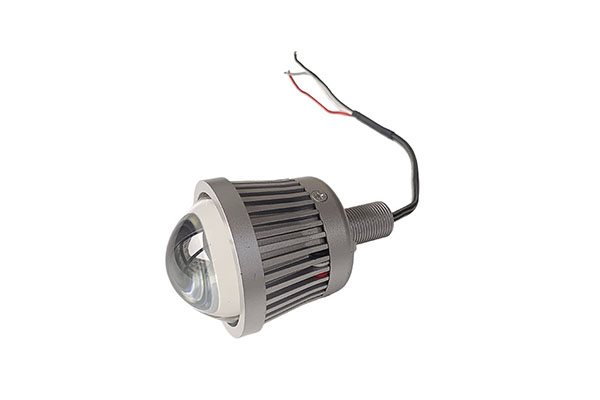How do high-strength engineering plastics ensure that headlight lens brackets retain their shape despite long-term use in high-temperature environments?
Release Time : 2025-08-19
In the sophisticated system of modern automotive design, headlights have long transcended simple illumination to become the most recognizable "eyes" of the vehicle's front face, embodying both brand language and technological aesthetics. Supporting the precise focus and stable operation of these "eyes" lies precisely in the headlight lens bracket—a crucial, precision component hidden deep within the lighting system. While hidden from direct view, its exceptional aesthetics and novelty silently safeguard driving safety and the essence of design.
Their beauty is primarily reflected in their precision, reliability, and seamless integration into the overall design. Headlight lens brackets are typically manufactured from high-strength engineering plastics (such as PBT and PA66) or lightweight aluminum alloys through precision injection molding or die-casting. Their structural design is rigorous, with dimensional tolerances controlled to the micron level. Their form is not arbitrary; it perfectly fits the complex internal spatial layout of the headlight, seamlessly integrating with components such as the reflector bowl, lens, and circuit board to form a compact and efficient optical system. The bracket's smooth, burr-free surface and strategically distributed reinforcement ribs ensure sufficient rigidity and creep resistance while also showcasing the "inherent beauty" of precision manufacturing. When the headlight assembly is illuminated, light is precisely projected forward. This is thanks to the bracket's stable support and precise alignment of the lens, ensuring perfect beam pattern cutting and smooth switching between high and low beams. This "beauty of order" created by high precision and adaptability is a silent testament to the modern automotive industry's pursuit of ultimate quality, making every beam of light an extension of the design.
The core of its "novelty" lies in its critical role as the "stability center" of the optical system and its technological integration. The primary task of the automotive headlight lens bracket is to ensure absolute lens stability under all driving conditions (bumps, vibrations, and temperature fluctuations). Any slight displacement could cause beam deviation, affecting the lighting effect and even causing glare to oncoming vehicles. Its "novelty" is reflected in its in-depth exploration of material properties and structural innovation. The use of high-temperature and aging-resistant engineering plastics ensures long-term deformation resistance in the high-temperature environment of the engine compartment. The metal bracket, through optimized structural design and surface treatment, achieves a balance between lightweight and high strength. Some high-end brackets also incorporate a fine-tuning mechanism, allowing for millimeter-level precision calibration of the lens angle during assembly or after-sales repair, ensuring perfect factory-set beam consistency. This innovative design, combining "stable support" with "precision adjustment," is fundamental to the reliable operation of modern automotive intelligent lighting (such as adaptive high beams and matrix headlights).
This novelty is also reflected in the continued pursuit of lightweighting and integration. With the trend towards electrification and intelligent vehicles, weight reduction is a constant theme. Through topological optimization, the bracket eliminates redundant material while maintaining strength, achieving a lightweight structure. Furthermore, bracket designs tend to integrate multiple functions, potentially carrying lenses, sensors (such as auxiliary brackets for cameras and radar), and even parts of the wiring harness. This simplifies the internal structure of the headlight and improves assembly efficiency and reliability. Furthermore, with the increasing prevalence of LED and laser headlights, heat dissipation requirements have increased. Some bracket designs now incorporate heat conduction paths to facilitate heat transfer and dissipation.
From a practical perspective, the novelty of the car headlight lens bracket lies in its dual contribution to active safety and brand value. A precise and stable lighting system is the first line of defense for nighttime driving safety. A reliable lens bracket ensures that every high beam activation and every light pattern change is accurate, safeguarding the safety of the driver and others. Furthermore, headlights are the face of a brand, and the sophistication and reliability of their internal structure indirectly reflect the overall vehicle's build quality and technological prowess.
The car headlight lens bracket, with its aesthetic appeal through precision manufacturing, high adaptability, and robust structure, and its novelty through optical stability, precise adjustment, lightweighting, and integrated design, has become an indispensable "behind-the-scenes contributor" to modern automotive lighting systems. Its aesthetic appeal lies in its harmonious coexistence and precise integration with the headlight assembly; its novelty lies in its subtle structural innovations, which ensure a significant safety mission and technological experience. Although it is hidden behind the lights, it supports the light that illuminates the way forward every time with absolute stability and precision, and is a well-deserved "silent guardian" in the automotive industry.
Their beauty is primarily reflected in their precision, reliability, and seamless integration into the overall design. Headlight lens brackets are typically manufactured from high-strength engineering plastics (such as PBT and PA66) or lightweight aluminum alloys through precision injection molding or die-casting. Their structural design is rigorous, with dimensional tolerances controlled to the micron level. Their form is not arbitrary; it perfectly fits the complex internal spatial layout of the headlight, seamlessly integrating with components such as the reflector bowl, lens, and circuit board to form a compact and efficient optical system. The bracket's smooth, burr-free surface and strategically distributed reinforcement ribs ensure sufficient rigidity and creep resistance while also showcasing the "inherent beauty" of precision manufacturing. When the headlight assembly is illuminated, light is precisely projected forward. This is thanks to the bracket's stable support and precise alignment of the lens, ensuring perfect beam pattern cutting and smooth switching between high and low beams. This "beauty of order" created by high precision and adaptability is a silent testament to the modern automotive industry's pursuit of ultimate quality, making every beam of light an extension of the design.
The core of its "novelty" lies in its critical role as the "stability center" of the optical system and its technological integration. The primary task of the automotive headlight lens bracket is to ensure absolute lens stability under all driving conditions (bumps, vibrations, and temperature fluctuations). Any slight displacement could cause beam deviation, affecting the lighting effect and even causing glare to oncoming vehicles. Its "novelty" is reflected in its in-depth exploration of material properties and structural innovation. The use of high-temperature and aging-resistant engineering plastics ensures long-term deformation resistance in the high-temperature environment of the engine compartment. The metal bracket, through optimized structural design and surface treatment, achieves a balance between lightweight and high strength. Some high-end brackets also incorporate a fine-tuning mechanism, allowing for millimeter-level precision calibration of the lens angle during assembly or after-sales repair, ensuring perfect factory-set beam consistency. This innovative design, combining "stable support" with "precision adjustment," is fundamental to the reliable operation of modern automotive intelligent lighting (such as adaptive high beams and matrix headlights).
This novelty is also reflected in the continued pursuit of lightweighting and integration. With the trend towards electrification and intelligent vehicles, weight reduction is a constant theme. Through topological optimization, the bracket eliminates redundant material while maintaining strength, achieving a lightweight structure. Furthermore, bracket designs tend to integrate multiple functions, potentially carrying lenses, sensors (such as auxiliary brackets for cameras and radar), and even parts of the wiring harness. This simplifies the internal structure of the headlight and improves assembly efficiency and reliability. Furthermore, with the increasing prevalence of LED and laser headlights, heat dissipation requirements have increased. Some bracket designs now incorporate heat conduction paths to facilitate heat transfer and dissipation.
From a practical perspective, the novelty of the car headlight lens bracket lies in its dual contribution to active safety and brand value. A precise and stable lighting system is the first line of defense for nighttime driving safety. A reliable lens bracket ensures that every high beam activation and every light pattern change is accurate, safeguarding the safety of the driver and others. Furthermore, headlights are the face of a brand, and the sophistication and reliability of their internal structure indirectly reflect the overall vehicle's build quality and technological prowess.
The car headlight lens bracket, with its aesthetic appeal through precision manufacturing, high adaptability, and robust structure, and its novelty through optical stability, precise adjustment, lightweighting, and integrated design, has become an indispensable "behind-the-scenes contributor" to modern automotive lighting systems. Its aesthetic appeal lies in its harmonious coexistence and precise integration with the headlight assembly; its novelty lies in its subtle structural innovations, which ensure a significant safety mission and technological experience. Although it is hidden behind the lights, it supports the light that illuminates the way forward every time with absolute stability and precision, and is a well-deserved "silent guardian" in the automotive industry.







